第三章 翻译的原则
- 格式:ppt
- 大小:292.00 KB
- 文档页数:24
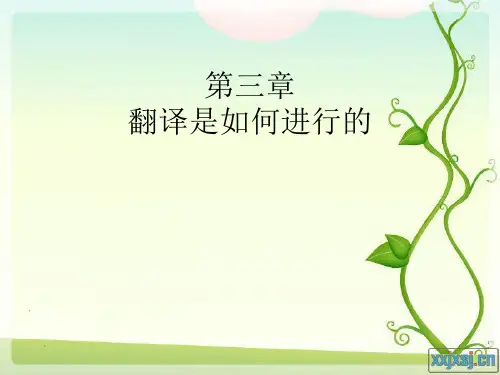
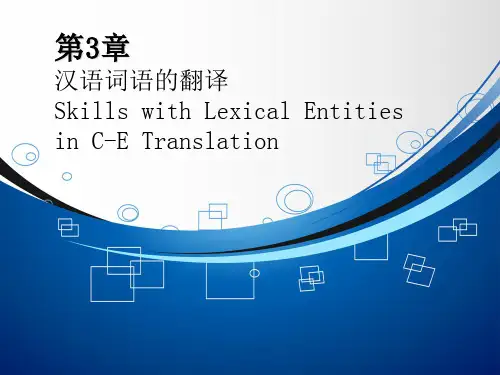
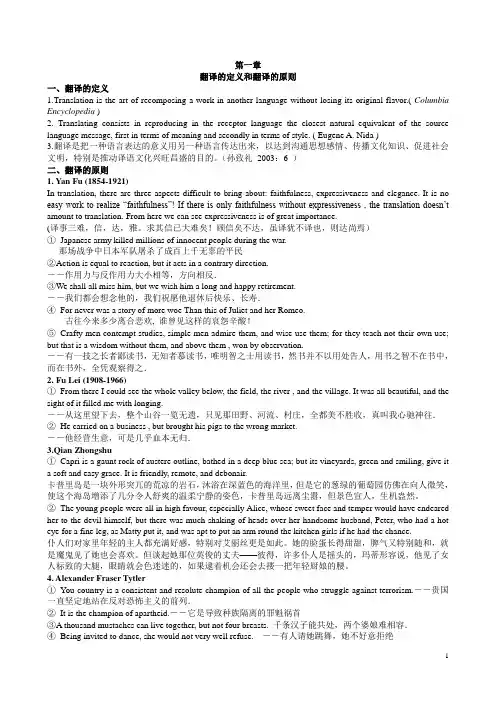
第一章翻译的定义和翻译的原则一、翻译的定义1.Translation is the art of recomposing a work in another language without losing its original flavor.( Columbia Encyclopedia )2. Translating consists in reproducing in the receptor language the closest natural equivalent of the source language message, first in terms of meaning and secondly in terms of style. ( Eugene A. Nida )3.翻译是把一种语言表达的意义用另一种语言传达出来,以达到沟通思想感情、传播文化知识、促进社会文明,特别是推动译语文化兴旺昌盛的目的。
(孙致礼2003:6 )二、翻译的原则1. Yan Fu (1854-1921)In translation, there are three aspects difficult to bring about: faithfulness, expressiveness and elegance. It is no easy work to realize ―faithfulness‖! If there is only faithfulness without expressiveness , the translation doesn’t amount to translation. From here we can see expressiveness is of great importance.(译事三难,信,达,雅。
求其信已大难矣!顾信矣不达,虽译犹不译也,则达尚焉)①Japanese army killed millions of innocent people during the war.----那场战争中日本军队屠杀了成百上千无辜的平民②Action is equal to reaction, but it acts in a contrary direction.――作用力与反作用力大小相等,方向相反.③We shall all miss him, but we wish him a long and happy retirement.――我们都会想念他的,我们祝愿他退休后快乐、长寿.④For never was a story of more woe Than this of Juliet and her Romeo.古往今来多少离合悲欢, 谁曾见这样的哀怨辛酸!⑤Crafty men contempt studies, simple men admire them, and wise use them; for they teach not their own use; but that is a wisdom without them, and above them , won by observation.――有一技之长者鄙读书,无知者慕读书,唯明智之士用读书,然书并不以用处告人,用书之智不在书中,而在书外,全凭观察得之.2. Fu Lei (1908-1966)①From there I could see the whole valley below, the field, the river , and the village. It was all beautiful, and the sight of it filled me with longing.――从这里望下去,整个山谷一览无遗,只见那田野、河流、村庄,全都美不胜收,真叫我心驰神往.②He carried on a business , but brought his pigs to the wrong market.――他经营生意,可是几乎血本无归.3.Qian Zhongshu①Capri is a gaunt rock of austere outline, bathed in a deep blue sea; but its vineyards, green and smiling, give ita soft and easy grace. It is friendly, remote, and debonair.卡普里岛是一块外形突兀的荒凉的岩石,沐浴在深蓝色的海洋里,但是它的葱绿的葡萄园仿佛在向人微笑,使这个海岛增添了几分令人舒爽的温柔宁静的姿色,卡普里岛远离尘嚣,但景色宣人,生机盎然。
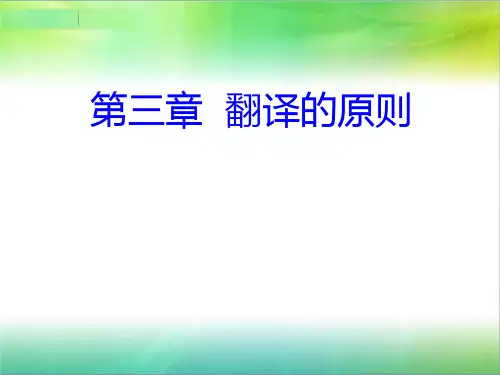
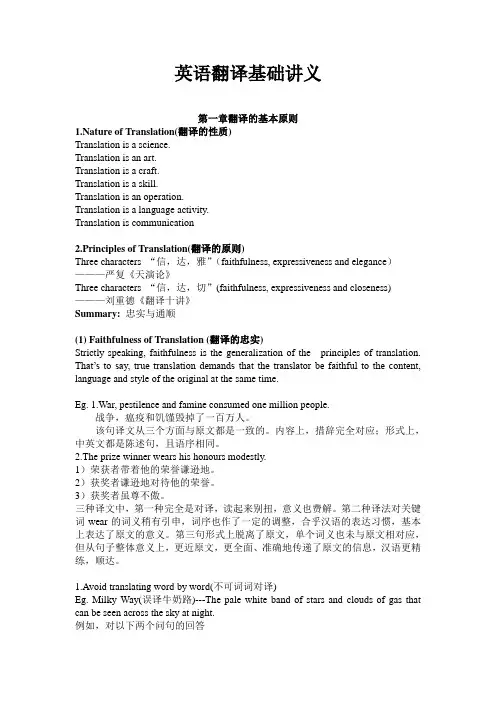
英语翻译基础讲义第一章翻译的基本原则1.Nature of Translation(翻译的性质)Translation is a science.Translation is an art.Translation is a craft.Translation is a skill.Translation is an operation.Translation is a language activity.Translation is communication2.Principles of Translation(翻译的原则)Three characters “信,达,雅”(faithfulness, expressiveness and elegance)———严复《天演论》Three characters “信,达,切”(faithfulness, expressiveness and closeness) ———刘重德《翻译十讲》Summary:忠实与通顺(1) Faithfulness of Translation (翻译的忠实)Strictly speaking, faithfulness is the generalization of the principles of translation. That’s to say, true translation demands that the translator be faithful to the content, language and style of the original at the same time.Eg. 1.War, pestilence and famine consumed one million people.战争,瘟疫和饥馑毁掉了一百万人。
该句译文从三个方面与原文都是一致的。
内容上,措辞完全对应;形式上,中英文都是陈述句,且语序相同。
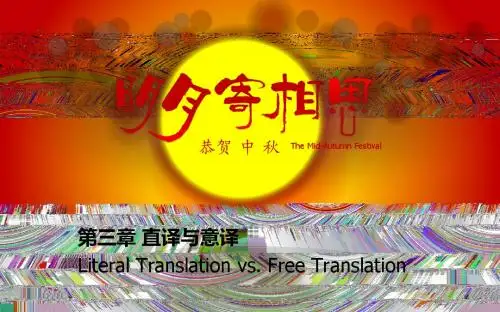
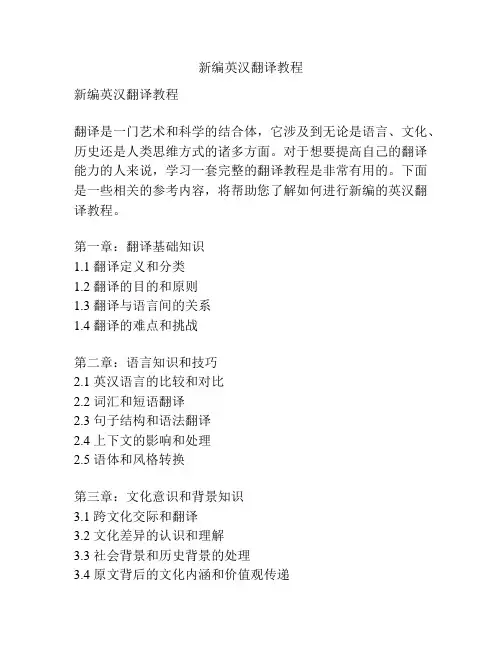
新编英汉翻译教程新编英汉翻译教程翻译是一门艺术和科学的结合体,它涉及到无论是语言、文化、历史还是人类思维方式的诸多方面。
对于想要提高自己的翻译能力的人来说,学习一套完整的翻译教程是非常有用的。
下面是一些相关的参考内容,将帮助您了解如何进行新编的英汉翻译教程。
第一章:翻译基础知识1.1 翻译定义和分类1.2 翻译的目的和原则1.3 翻译与语言间的关系1.4 翻译的难点和挑战第二章:语言知识和技巧2.1 英汉语言的比较和对比2.2 词汇和短语翻译2.3 句子结构和语法翻译2.4 上下文的影响和处理2.5 语体和风格转换第三章:文化意识和背景知识3.1 跨文化交际和翻译3.2 文化差异的认识和理解3.3 社会背景和历史背景的处理3.4 原文背后的文化内涵和价值观传递第四章:专业领域和行业知识4.1 法律翻译原则和技巧4.2 医学翻译原则和技巧4.3 经济与商务翻译原则和技巧4.4 技术与科学翻译原则和技巧第五章:翻译工具和资源5.1 电子词典和在线翻译工具的使用5.2 术语库和翻译记忆库的建立和管理5.3 翻译软件的使用和技巧5.4 翻译资源和参考文献的查找和使用第六章:翻译实践和技巧6.1 阅读和理解原文的重要性6.2 提高译文的准确性和流畅度6.3 校对和修改译文的技巧6.4 学习和借鉴他人的优秀翻译作品第七章:发展和推广翻译技能7.1 参加翻译考试和认证7.2 加入翻译协会和社区7.3 进修和继续教育的机会7.4 与客户和雇主建立有效的沟通通过学习以上内容,您将逐步掌握新编英汉翻译的基本理论和技巧。
同时,您还可以在实践中不断提高自己的翻译能力,并且了解如何将翻译技能应用到不同的专业领域中。
通过继续学习和积累实践经验,您将成为一名优秀的英汉翻译专业人员。
值得一提的是,在学习翻译过程中,积极参与翻译实践是至关重要的。
可以选择翻译新闻、文学作品、商业文件等不同类型的材料,并进行翻译和校对实践。
此外,与他人分享您的翻译作品、参加翻译比赛和与其他翻译专业人士的交流也是提高翻译能力的有效途径。

Subordination分清主从1. Nominative AbsoluteA. n. + present participle phrase◆到处都可以看见人们穿着节日服装,满脸笑容。
Everywhere you can see people in their holiday dresses, their faces shining with smiles.◆天气要是合适的话,我们明天要到西山去玩。
Weather promising, we’ll go on an excursion to the Western Hill tomorrow.B. n. + past participle phrase◆他脸朝天,头枕着手躺着。
He lay on his back, his face up and his hands crossed under his head.◆他做完作业后回家去了。
His work done, he went home.C. n. + adjective phrase◆他鼻子冻得通红地走进房来。
He came into my room, his nose red with cold.◆老头坐了下来,由于痛苦脸色发白,两颊上还带有泪痕。
The old man sat down, his face pale with pain and traces of tears on his cheeks.D. n. + adverbial phrase◆她伸出双手,掌心向上。
She put out her hands, palms up.◆他袜子穿反了。
He put on his socks, wrong side out.E. n. + n.◆数以千计的船民被淹死,其中许多是小孩。
Thousands of boat people were drowned, many of them children.◆他的第一个剧本成功后,又写了另一个剧本。
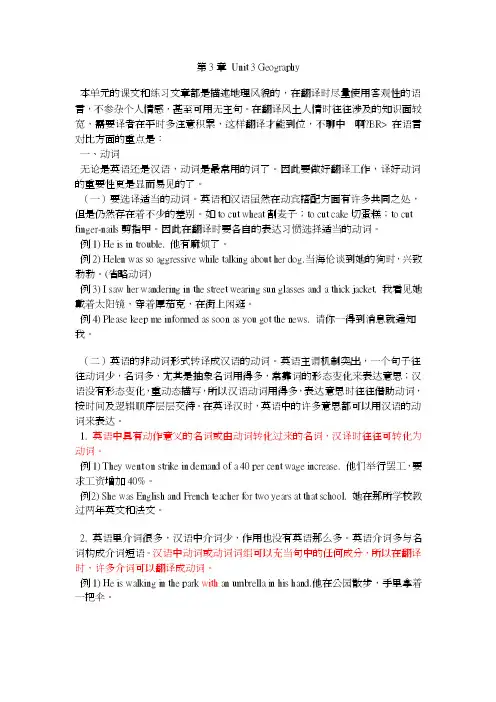
第3章Unit 3 Geography本单元的课文和练习文章都是描述地理风貌的,在翻译时尽量使用客观性的语言,不参杂个人情感,甚至可用无主句。
在翻译风土人情时往往涉及的知识面较宽,需要译者在帄时多注意积累,这样翻译才能到位,不聊中 啊?BR> 在语言对比方面的重点是:一、动词无论是英语还是汉语,动词是最常用的词了。
因此要做好翻译工作,译好动词的重要性更是显而易见的了。
(一)要选译适当的动词。
英语和汉语虽然在动宾搭配方面有许多共同之处,但是仍然存在着不少的差别。
如to cut wheat割麦子;to cut cake切蛋糕;to cut finger-nails剪指甲。
因此在翻译时要各自的表达习惯选择适当的动词。
例1) He is in trouble. 他有麻烦了。
例2) Helen was so aggressive while talking about her dog.当海伦谈到她的狗时,兴致勃勃。
(省略动词)例3) I saw her wandering in the street wearing sun glasses and a thick jacket. 我看见她戴着太阳镜,穿着厚茄克,在街上闲逛。
例4) Please keep me informed as soon as you got the news. 请你一得到消息就通知我。
(二)英语的非动词形式转译成汉语的动词。
英语主谓机制突出,一个句子往往动词少,名词多,尤其是抽象名词用得多,常靠词的形态变化来表达意思;汉语没有形态变化,重动态描写,所以汉语动词用得多,表达意思时往往借助动词,按时间及逻辑顺序层层交待。
在英译汉时,英语中的许多意思都可以用汉语的动词来表达。
1. 英语中具有动作意义的名词或由动词转化过来的名词,汉译时往往可转化为动词。
例1) They went on strike in demand of a 40 per cent wage increase. 他们举行罢工,要求工资增加40%。
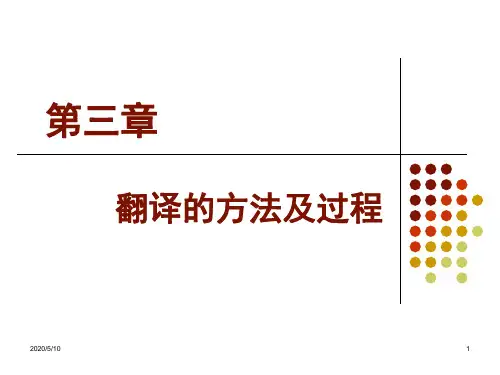
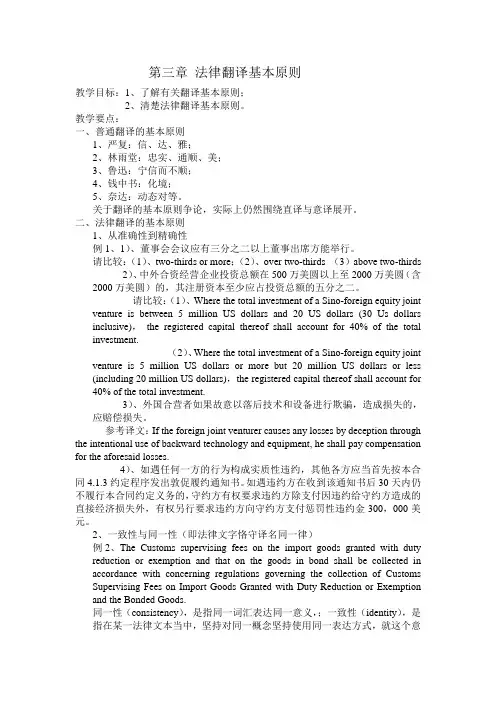
第三章法律翻译基本原则教学目标:1、了解有关翻译基本原则;2、清楚法律翻译基本原则。
教学要点:一、普通翻译的基本原则1、严复:信、达、雅;2、林雨堂:忠实、通顺、美;3、鲁迅:宁信而不顺;4、钱中书:化境;5、奈达:动态对等。
关于翻译的基本原则争论,实际上仍然围绕直译与意译展开。
二、法律翻译的基本原则1、从准确性到精确性例1、1)、董事会会议应有三分之二以上董事出席方能举行。
请比较:(1)、two-thirds or more;(2)、over two-thirds (3)above two-thirds 2)、中外合资经营企业投资总额在500万美圆以上至2000万美圆(含2000万美圆)的,其注册资本至少应占投资总额的五分之二。
请比较:(1)、Where the total investment of a Sino-foreign equity joint venture is between 5 million US dollars and 20 US dollars (30 Us dollars inclusive),the registered capital thereof shall account for 40% of the total investment.(2)、Where the total investment of a Sino-foreign equity joint venture is 5 million US dollars or more but 20 million US dollars or less (including 20 million US dollars),the registered capital thereof shall account for 40% of the total investment.3)、外国合营者如果故意以落后技术和设备进行欺骗,造成损失的,应赔偿损失。
翻译管理制度范文翻译管理制度第一章总则第一条为了规范翻译工作,提高翻译质量,保障翻译工作的顺利开展,根据有关法律法规,制定本制度。
第二条本制度适用于本单位内对外翻译工作,包括但不限于文件、会议、协议等翻译工作。
第三条翻译工作应遵循准确、完整、忠实、通顺的原则,确保翻译成果与原文一致,保持其真实性和可靠性。
第四条翻译工作应当按照工作任务分配,分工明确,流程清晰,责任明确。
第五条提供翻译执业服务的人员应遵守职业道德规范,秉持诚实守信、保密自律的原则。
第二章翻译流程第六条翻译工作应按照以下流程进行:一、确定翻译任务:甲方提出翻译需求,与乙方协商确定翻译任务的内容、要求、期限等细节。
二、准备工作:乙方对翻译任务进行策划和准备,包括收集所需资料、了解专业背景和领域知识等。
三、翻译实施:乙方根据翻译任务的要求进行翻译工作,确保准确、通顺、忠实地将原文翻译成目标语言。
四、复核校对:乙方对翻译成果进行自我复核,确保翻译质量。
同时可以请其他资深翻译人员进行校对审核。
五、交付验收:乙方按期完成翻译,将成果交付甲方,并由甲方进行验收。
如有需要,可以进行修改和修订。
第七条翻译工作要遵守及时、高效、严谨的原则,确保按时完成翻译任务。
第八条在翻译成果交付前,乙方应对翻译成果进行仔细审校,确保翻译质量,防止错漏。
第三章翻译人员管理第九条翻译人员应具备以下条件:一、具有良好的外语听、说、读、写能力,能够准确把握原文的含义,确保翻译质量。
二、具备丰富的专业知识和领域背景,能够理解专业术语和行业用语。
三、具备较强的文字表达能力,能够准确地将原文理解并转化为目标语言。
第十条翻译人员应遵守职业道德规范,保持诚实守信、保密自律的行为,维护翻译行业的形象。
第十一条翻译人员应按照任务分工进行工作,确保翻译工作的顺利进行。
第十二条翻译人员应不断提升自身翻译水平和专业知识,参加相关培训和学术交流,提高自身素质。
第四章翻译质量控制第十三条翻译任务交付前,乙方应对翻译成果进行自我审校,确保翻译质量。
第三章翻译常用的八种技巧(中)第五节词序调整法Inversion词序调整法的英语inversion一词,不能译成“倒译”、“倒译法”或“颠倒词序”之类,否则容易和语法中的“倒装”概念相混淆。
Inversion作为一种翻译技巧,其意思为,翻译时对词序作必要或必不可少的改变,并不只是纯粹的颠倒词序或倒装。
某些语言学家所说的九种倒装,是语法概念,是指同一种语言内的倒装情况,有其各自独特的语言构成方式。
这些情况与方式和它们被译成另一种语言后的语言构成形式并非完全相同。
试对照每种倒装例句的英文及其译文:l.Interrogative inversion (疑问倒装):What did you do yesterday? (你昨天干什么?)2.Imperative inversion (命令倒装):“Speak you,” said Mr.Black, “speak you,good fellow!” (布莱克先生命令道:“说,说吧!伙计!”) 3.Exclamatory inversion (惊叹倒装):How dreadful is this place! (这地方好可怕啊!)4.Hypothetical inversion (假设倒装):Had you come yesterday,you could have seen him here.(要是你昨天来了,你就会在这里看到他的。
) 5.Balance inversion (平衡倒装):Through a gap came an elaborately described ray.(从一个空洞透出一束精心描绘的光线。
)6.Link inversion (衔接倒装):On this depends the whole argument. (整个争论都以此为论据。
)7.Signpost inversion (点题倒装)By strategy is meant some thing wider. (战略的意义比较广。